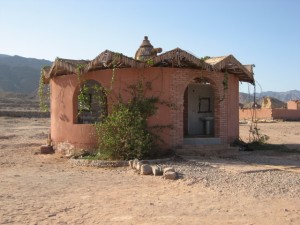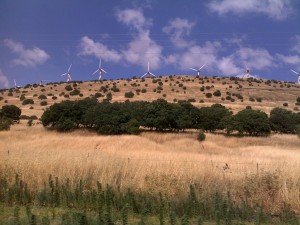
The Svalbard Global Seed Vault locked safe away in Norway has once again opened its steel doors welcoming 25,000 new seed samples including varieties of chickpeas, fava beans and other seeds from Syria. Around 110,000 Syrian duplicate seed samples out of 750,000 samples stored in Syria have been safely consigned, should the conflict in Syria destroy national seed banks (as happened in Afghanistan and Iraq), at least we are sure that some of the local and ancient agricultural biodiversity has been salvaged.
Opened in 2008, and ranked as the 6th “Time’s Best invention”, the Svalbard vault is the world’s main back up of duplicate seeds collected. More than half a million samples are safely deposited on behalf of 1,750 genebanks from around the world; this “seed deposit service” is provided free of charge thanks to the Norwegian government and the Global Crop Diversity Trust which cover all operational costs. The facility, which cost 9 million USD , has been funded entirely by the Norwegian government and it has a very neat apocalyptic feel to it.
Sunk 125 meters into the Norwegian permafrost, outside the village of Longyearbyen one of the world’s most northerly habitation, the vault is maintained at a constant temperature of -18 degrees Celsius, the concave tunnel head is designed to deflect missile strikes, and the vault has been built deep enough into the mountain to withstand nuclear explosion and rising sea level. Oh, and in case electricity happened to cut off, it would take two centuries for the vault to warm to freezing point. It is not surprising that such precautions have led the Svalbard vault to be nicknamed as the Doomsday Vault, pictured below.

Seed Vault image via Wikipedia
The FAO estimates that 75% of crop biodiversity has been lost since the 1900’s; just over a century ago India had over 100,000 varieties of rice compared to a few 1,000 nowadays. Faced with such worrying figures on biodiversity loss, all in all the Doomsday vault seems like a practical insurance policy to protect global agricultural biodiversity against future blights such as pest, disease, climate change, flooding and droughts. Furthermore, the terms and conditions seem relatively innocuous: researchers, plant breeders, companies and scientists do not have direct access to the seeds and instead must request samples from the depositing gene banks from the country of origin.
So far, so good. Yet if we dig a little deeper we discover some additional factors which might make us think twice before rejoicing, writing a victorious article about how the Svalbard vault is saving our biodiversity and hi-fiving our fellow “save the earth buddy”.
The power of holding genetic information:
First, the idea of a global seed bank is important, and we must pursue it as long as it doesn’t discourage individuals, farmers and national-level seed banks to retain and look after their own seeds.
More importantly, although the idea of the Svalbard seed vault was conceived in the 1980’s, fears of biopiracy have hindered its construction. It is only after the International Treaty on Plant Genetic Resources for Food and Agriculture, which entered into force in 2004, that the idea of a global seed vault became legally accepted. The treaty aims at “establishing a global system to provide farmers, plant breeders and scientists with access to plant genetic materials” and supposedly “ensuring that recipients share benefits they derive from the use of these genetic materials with the countries where they have been originated.”
But please stop for a second and think about this in practical terms. Can and will a farmer, faced with the wonderful jargonated (if this is even a word), convoluted, legal framework of a multilateral agreement REALLY have access to plant genetic materials? Would they even know about the “services” offered by Svalbard? And even if they did, would they necessarily have the financial resources and means to be able to request their own seeds from Svalbard, if they were ever to (God forbid) no longer exist in his own country? Who do you think would have the easiest access to this genetic information: farmers, plant breeders or scientists?
I really believe that this system offers no real “power” for the farmer to decide what, when and how to use any particular seed. The legal team of the Center for Food Safety has investigated the legal framework behind the deposit agreements at Svalbard. The point was to see if in some way the contract between Svalbard and depositors created an advantage for these corporations in their efforts to control and patent seed genetics. As the legal memorandum revealed that the answer to the question is a big, fat “yes.” The Svalbard agreement does provide corporations seeking to patent plant genetics additional advantages.
The efficacy of seed banks:
Other reasons to be wary of relying solely on Svalbard in particular, or seed banks in general, is that seed banks rarely store plant varieties that do not produce seeds such as berries, nuts and tubers which are integral in a human diet. Also, will the frozen or stored seeds be able to grow in a climate and soil which are likely to change in the future? As we know nature is constantly evolving to adapt, perceiving the seed as a potential life that can stand the test of time is perhaps wrong, especially in the face of rapid climate change.
So the real question is how can farmers guarantee a constant supply of their own seed varieties that adapt to localized evolving conditions?
The answer is quite simple, by ensuring that traditional varieties are being harvested.
Biodiversity is a public good,many may not realize its importance until it is too late so governments,individuals, and communities also have a role to incentivize the preservation of indigenous biodiversity. An example of this is the community led mobile biodiversity festival in India.
Seedy business?
The GMO industry is buttressed by monsters, not giants, such as the famous Monsanto, Syngenta, DuPont and Dow Chemical. These are happily funded by the USAID, and other philanthropic groups such as the Rockefeller foundation and Bill and Melinda Gates foundation. They have been marketing the use of GMO s and have been cajoling farmers to abandon old seeds varieties, for new hybrids, which (falsely) promise yield increases of 21-43%. The fierce marketing strategies, have led to an inevitable rush for hybrids while trampling over precious indigenous genetic resources. The consequences are disastrous: Monocropping has eliminated variety while contamination of non-GMOs crops is threatening the organic business. Terminator seeds have been developed to create dependence on unaffordable GMO seeds, which have indebted many farmers and we know the rest of the story (if you don’t please watch Life Running out of Control )
Yet how is it that the same organizations (and philanthropists) that have promoted GMOs are also financing the Global Doomsday seed vault? This is a huge contradiction. Why would you promote mono-cropping and biodiversity preservation at the same time?
As F. William Engdahl, author of Seeds of Destruction: The Hidden Agenda of Genetic Manipulation, points out:
“What leads the Gates and Rockefeller foundations to at one and the same time back proliferation of patented and soon-to-be Terminator patented seeds across Africa, a process which, as it has in every other place on earth, destroyed the plant seed varieties as monoculture industrialized agribusiness is introduced; and at the same time invest tens of millions of dollars to preserve every seed variety known in a bomb-proof doomsday vault near the remote Arctic Circle ‘so that crop diversity can be conserved for the future’ to restate their official release?”
Let’s not forget Henry Kissinger’s quote:
“If you control the oil you control the country; if you control food, you control the population.”
Monsanto’s recent purchase of Seminis and De Ruiter Seeds, makes them the largest GMO seed company on earth, controlling approximately 85% of the market. I am not so convinced about what is going on here, in fact I am worried.
I do not know how much control Monsanto and other GMO companies will have on the genetic information held at the Svalbard Global seed Vault, laws are easy to bend and twist- especially if you are powerful.
Amidst the crude civil war currently going on in Syria, the service provided by the Svalbard Global seed Vault to Syria is welcomed, as long as it doesn’t become a way to control the destiny of Syria’s (and indeed global) food supplies.
For more information please read :Seed Saving and Seed Banks.
Top image of keyhole and green from Shutterstock




It’s food for though. Linda, thank you for sharing this article. It is very important to have a different point of view about this subject. The question that remain is: how to protect biodiversity in a global perspective? I heard many stories that people came to AMAZON FOREST and take seeds samples for scientific purpose when, in fact, they were kind of stealing genetic information to build farmaceutical produts which, in turn, was selled back to the country of origin for an unaffordable prices. How can it be possible?
It is a question of sovereignty or we are talking about global rights that must be protected in favor of the world population?
Let me know your opinion about that.
Fabio.